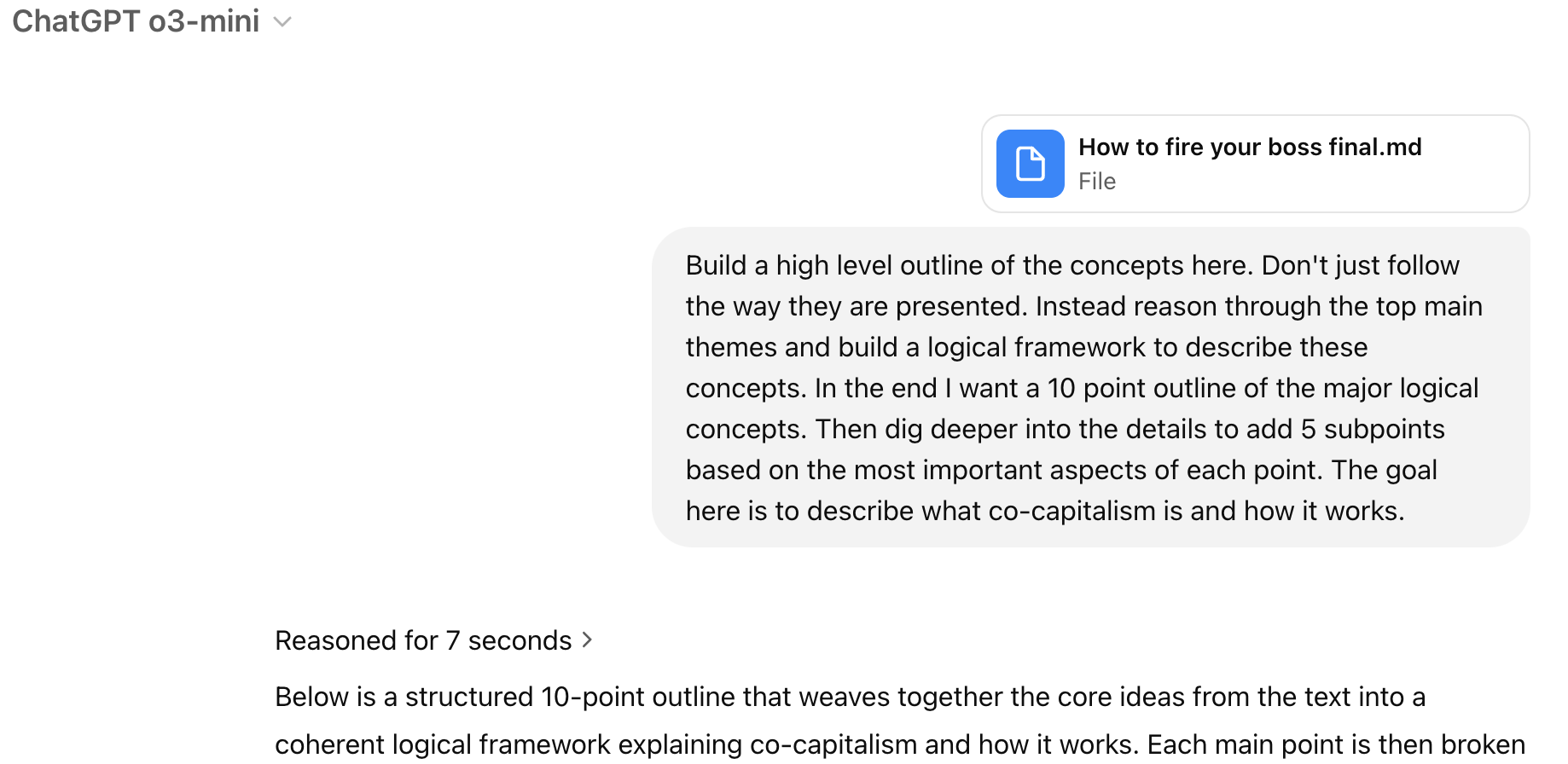GPT’s take on Fire Your Boss
I could pay to have some highly recognized individual give a hot take on why you need to read How to Fire Your Boss and Redeem the Economy. But it seems better to just give you the outline that GPT gleaned from the book, describing the fundamentals of co-capitalism. Here it is, with minor edits:
Critique of Traditional Hierarchy
• Recognizes that conventional boss–employee structures inherently limit individual autonomy.
• Points out how top–down control stifles creativity, innovation, and productivity.
• Explains that hierarchical models are designed primarily for margin maximization at the cost of meaningful value.
• Highlights the inefficiencies and communication silos created by layered authority.
• Illustrates how these structures lead to disengagement, burnout, and a misalignment between personal aspirations and organizational goals.The Need for a Paradigm Shift
• Identifies the widespread discontent with traditional work models and the “work sucks” mentality.
• Emphasizes that everyone deserves a fair share of the value they create.
• Argues for systems that put people’s value contribution and creativity at the center.
• Stresses the urgency of change in the face of technological and societal shifts (including the rise of AI).
• Frames the transformation as a necessary evolution toward more humane and productive work cultures.The Emergence of Co‑Capitalism
• Defines co‑capitalism as a value‑focused, team‑driven enterprise without the traditional boss.
• Blends free‑market principles with democratic, self‑managed organizational models.
• Suggests that replacing hierarchy with collective ownership creates a win–win for workers and businesses.
• Citing billion-dollar businesses that have proven these models, describes how shared control and revenue distribution improve both satisfaction and profitability.
• Presents co‑capitalism as a “third way” that balances individual initiative with collective goals.Pillar of Agency: Empowerment and Autonomy
• Advocates for transferring decision-making power from a single authority to the collective.
• Emphasizes that real productivity and creativity emerge when individuals control their work.
• Outlines mechanisms (such as self‑management and decentralized guidelines) that promote individual initiative.
• Shows that peer accountability can replace top–down oversight effectively.
• Recognizes that when individuals are empowered to provide value, they contribute to a society where work improves lives and enriches communities, making our world more vibrant.Pillar of Value: Direct Link Between Effort and Reward
• Establishes value creation as the central metric for success rather than hours worked or compliance.
• Aligns revenue distribution directly with the quality and impact of work.
• Encourages individuals to pursue their passions, thereby unleashing latent potential.
• Promotes the idea that when value is recognized and shared, both individuals and teams thrive.
• Illustrates how this model can lead to compounding advantages and better market outcomes.Pillar of Alignment: Coordination and Shared Vision
• Advocates for robust, transparent communication channels that keep all members informed.
• Emphasizes the importance of shared decision‑making to ensure every voice is heard.
• Highlights tools and practices (like democratic voting or consensus building) that align team efforts.
• Ensures that personal goals and collective missions are in constant dialogue.
• Fosters a culture where coordination replaces rigid reporting lines, reducing conflict and fostering innovation.Democratic Decision‑Making and Collective Control
• Introduces systems where decisions are made by the group rather than a single authority figure.
• Illustrates the use of general assemblies, voting, and participatory committees (e.g., Mondragón’s model).
• Ensures transparency and accountability through shared oversight.
• Encourages dialogue and debate to refine ideas before implementation.
• Establishes processes that mitigate groupthink while harnessing diverse perspectives.Practical Tools and Structures for Implementation
• Recommends adopting modern communication and project management tools (e.g., Slack, Trello, Notion) to support decentralized work.
• Lays out step‑by‑step “cookbook” approaches for both radical overhaul and incremental change.
• Details the importance of setting clear guidelines, metrics, and incentive structures.
• Offers examples of companies (like Morning Star and Valve) that successfully operate under decentralized frameworks.
• Describes the need for continuous training and re‑education to shift mindsets away from traditional hierarchy.Transition Strategies: Firing Your Boss Versus Incremental Change
• Differentiates between complete organizational overhaul and practical changes within existing structures.
• Provides a spectrum of strategies—from full entrepreneurial breakaway to small, internal shifts.
• Advises on the risks and rewards of stepping up and taking personal initiative.
• Suggests ways to begin with “slow starting” methods that reclaim agency even within current systems.
• Emphasizes that even small changes can pave the way for broader, systemic transformation.Future Implications and Broader Impact
• Discusses how co‑capitalism could reshape the broader economy and work culture.
• Envisions a future where technology (including AI) amplifies the benefits of decentralized work models.
• Frames the model as not only economically viable but also as enhancing democratic participation in the workplace.
• Explores potential challenges in scaling such systems and the need for adaptive frameworks.
• Recognizes that a societal focus on creating value means that as we work to provide genuine improvements, our collective efforts lead to a more vibrant, just, and sustainable world for all.

